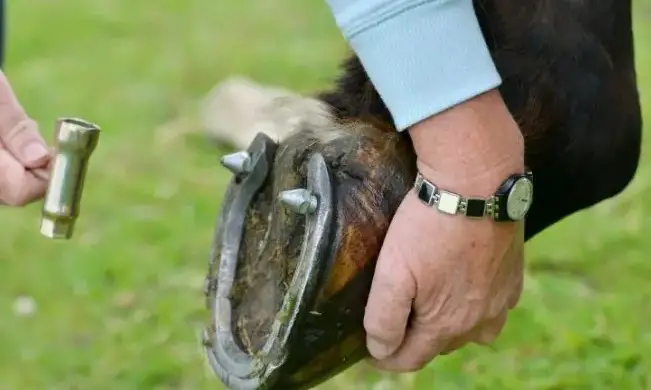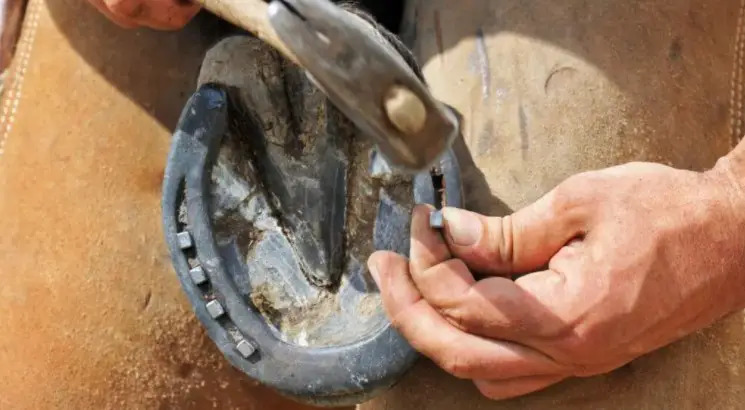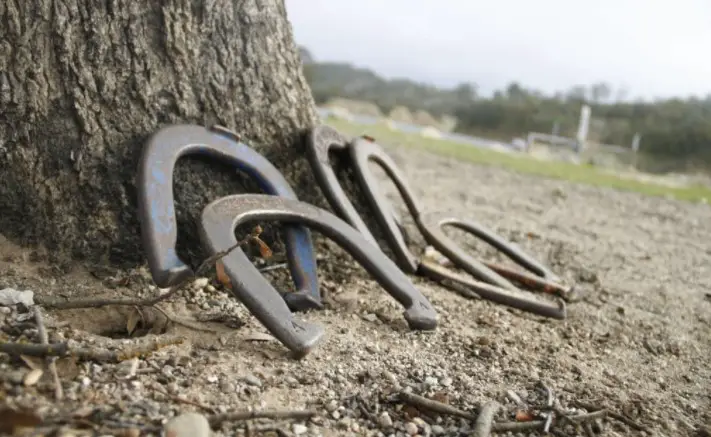Horseshoes are a symbol of good luck worldwide, but are they comfortable for the horses? How do they feel when they wear horseshoes? As an equestrian, you must be using horseshoes to protect your horse’s feet and enhance its hooves. However, for horses, horseshoes are more than that.
Shoeing the horse is a century-old practice, and its primary purpose is to protect the hooves. It may have seemed pretty painful if you have ever seen the shoeing process. However, it isn’t that bad, especially if you use correctly fitted horseshoes.
A horse needs to wear horseshoes for multiple reasons. Most importantly, horseshoes protect the horse’s feet if it rides on dangerous terrain. It also depends on the horse’s needs and the type of work or rides the horse does. This guide will explore all you need to know about these curved metals called horseshoes.
What is the Purpose of Using Horseshoes?
Horseshoes have a U-shape and are designed to protect the horse’s hooves. It is made of aluminum or steel and is attached to the horse’s feet by being nailed to them. Without hurting them, a skilled farrier can quickly nail the shoes to the hooves.

The primary purpose of using horseshoes is to prevent the horse’s hooves from wearing down too early. Horses who move or ride a lot will gradually wear down their hooves, especially if the terrain is rugged or arid. Additionally, the horseshoes protect the rocky ground. They help prevent injuries if the horse is used for riding purposes or pulling heavy carriages or loads. Apart from safety, horseshoes are used for several other purposes. For example:
- For corrective purposes: When evaluating a horse’s hooves, an experienced farrier might use a corrective horseshoe to support the horse’s balance. A suitable horseshoe can provide additional support to the horse’s leg if it’s suffering from imbalance.
- To add stability and traction: Horses can face stability and grip issues, especially during poor weather conditions or when the terrain is muddy or uneven. Horseshoes can be helpful in such situations as they help the horse to have a greater grip on the ground.
- For medical purposes: Horseshoes are also beneficial for medical purposes. If a horse has arthritis, laminitis, or ringbone, shoeing can help solve these issues. Horseshoes will help such horses to remain comfortable and walk or run with ease.
Horses can wear different types of shoes depending on their needs and work. For example, some horseshoes are harder and durable, while others are light and soft. In addition, a racehorse needs more lightweight shoes to move on the tracks swiftly and have more grip on the ground. In short, horseshoes are beneficial for several reasons; they improve overall performance.
Are Horseshoes Cruel and Barbaric?
Since the farrier installs the horseshoes into the wall of the horse’s hoof, it may seem cruel and barbaric. The shoeing process has led many of us to believe that the installation of horseshoes is a painful act.
However, in reality, it doesn’t hurt as the nails go into the hooves because there are no nerves. Meaning that there is no sensation, making the installation and removal of horseshoes painless.

Suppose you see a horse resisting or flinching while shoeing; you should know that it is doing so because of confusion and not pain. Taking off or putting on horseshoes is similar to clipping your nails. You don’t have any nerves there that could cause you pain. It’s the reason several people across the world are habitual nail biters because they simply don’t feel any discomfort while doing so. The same thing applies to horses and you can think of the hooves as their nails.
An experienced and professional farrier can quickly put the horseshoes on without hurting the horse. If the farrier fails to do this properly, the nail can enter other parts of the hoof, such as the frog or the sole. If this happens while hammering the nail into the hoof, it can be excruciating for the horse and lead to infection. This is why it’s important that only an experienced farrier shoes a horse.
Do All Horses Need Horseshoes?
Whether a horse needs horseshoes depends on the type of work it does and the terrain on which it rides. Different horses have different purposes. For example, horses used for transportation or work purposes need to have their hooves protected. These horses usually run on rugged and rough terrains, and their hooves can get damaged.
Without horseshoes, a horse can get injured more easily. However, a horse that lives primarily on the soft grass and spends its day grazing doesn’t need protection for its feet. To decide whether your horse needs a horseshoe or not, you need to consider these factors because each horse is different.
What Are the Pros and Cons of Horseshoes?
Pros
There is a lot of discussion among the equestrians. Some of them discuss whether to leave their horses barefoot or use horseshoes. According to some people, horses shouldn’t wear horseshoes at all. They say that horseshoes can cause damage to the hooves and weaken them. Others debate that we can’t deny the benefits of horseshoes. Following are the pros of horseshoes:

- Horseshoes protect the hooves from injuries and damage. They add to the strength and durability and help in performing intense work.
- Shoes prevent the hooves from wearing out quickly. This feature can be helpful for those horses that need to pull carriages and are involved in other weight-bearing tasks.
- Corrective horseshoes can help in solving various issues. For example, if the horse has balance problems, horseshoes can help correct them. Other problems that can be rectified using horseshoes are the horse’s gait and stride and cracks or chips in the hooves.
- Horseshoes can enhance the overall performance, especially for racehorses. Horses that participate in cross country work, high-impact events, or high-level jumping can perform better with horseshoes..
- Horses suffering from arthritis, laminitis, or ringbone can benefit from horseshoes. Horseshoes provide additional support, which can help treat such health conditions.
- Horseshoes prevent slipping as they provide traction and grip. Slipping can cause injury to both the horse and the rider. Using slip-resistant horseshoes can help to avoid accidents.
Cons
While there are many benefits of shoeing a horse, there are some cons too that you might consider if you’re an equestrian. Following are the risks involved with shoeing a horse:
- If a farrier is not experienced and does not install the horseshoe properly, the horse is at risk of being injured. Hot or rogue nails can damage the sensitive inner portion of the hooves.
- If a horse loses its shoe or springs it during working or running, it can damage the hoof wall or cause a tendon sprain.
- Horseshoes are more expensive than just trimming. If you want to cut costs, you can keep your horse barefoot.
Final Thoughts
Horseshoes are sometimes considered to be cruel, but the truth is that the shoeing process is not hurtful when done by a skilled farrier. Horseshoes can help correct instability or other health issues, provide good traction and support, and, most importantly, protect horses’ hooves. Whether you keep your horse barefoot or shod is up to you, but at least now you know that horseshoes don’t hurt horses.
